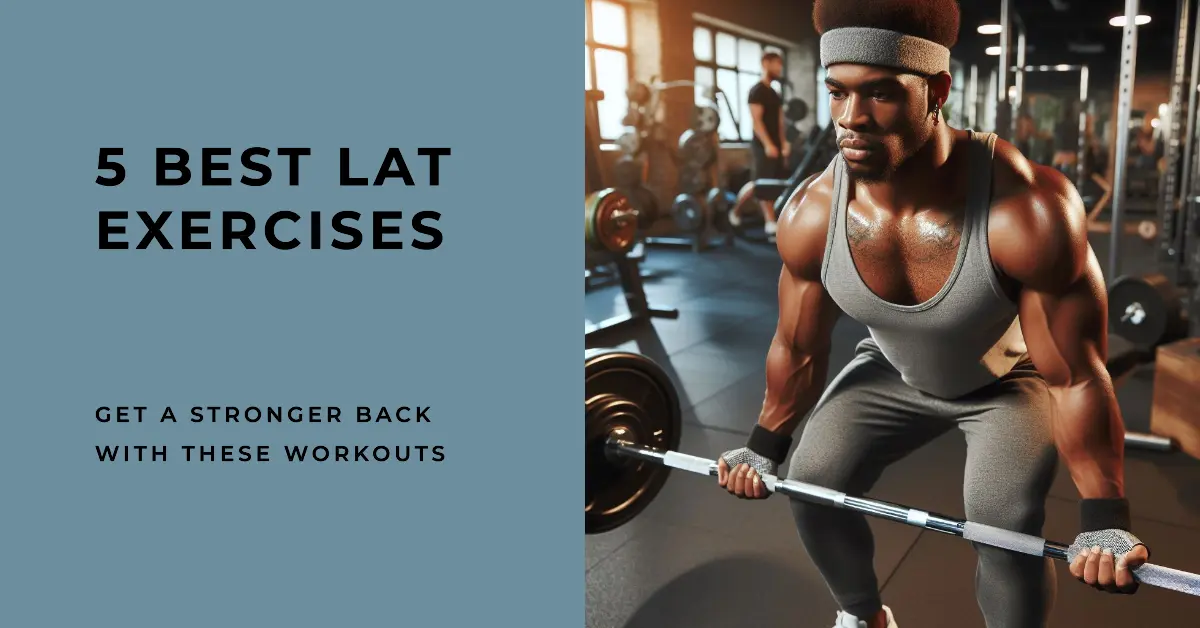If you’re looking to build a strong back, focusing on your latissimus dorsi muscles is crucial. The latissimus dorsi, commonly referred to as the “lats,” ar.e the largest muscles in your back and play a significant role in different upper body movements Including specific exercises targeting the lats into your workout routine can help you achieve a well-defined, powerful back. In this article, we’ll explore the five best lat exercises that will help you achieve a strong and sculpted back.
What are Lat Exercises?
Lat exercises, short for latissimus dorsi exercises, specifically target the latissimus dorsi muscles, which are located on either side of the back. These muscles are responsible for different movements involving the arms and shoulders, including pulling, lifting, and rotating. By performing lat exercises, people can effectively strengthen and develop their back muscles, leading to improved posture, increased upper body strength, and improved athletic performance. Including lat exercises into your workout routine can contribute to overall muscle balance and functional fitness.
Importance of a Strong Back
Having a strong back is crucial for overall health and well-being. The back muscles, particularly the latissimus dorsi, play an important role in supporting the spine, maintaining posture, and facilitating different movements. A strong back helps prevent injuries, reduces back pain, and enhances athletic performance. Additionally, a well-developed back contributes to a balanced physique, improving aesthetics and boosting confidence. Whether you’re engaging in daily activities or participating in sports and fitness activities, a strong back is important for optimal physical function and longevity.
Understanding the Latissimus Dorsi Muscle
The latissimus dorsi muscle is a broad, flat muscle that spans the width of the back. It originates from the lower spine and iliac crest and inserts into the upper arm bone (humerus). Its primary function is to bring the upper arms close to the body, as well as extend and internally rotate the shoulder joint. Strengthening the lats not only adds width and thickness to your back but also improves overall upper body strength and stability.
Benefits of Lat Exercises
Lat exercises offer numerous benefits for overall fitness and well-being. Which includes:
- Strengthening the Latissimus Dorsi: Lat exercises target the latissimus dorsi muscles, which are crucial for different upper body movements.
- Improved Posture: Strengthening the back muscles through lat exercises helps to maintain proper posture, reducing the risk of slouching or rounded shoulders.
- Reduced Risk of Back Pain: A strong back, achieved through lat exercises, provides better support to the spine, reducing the likelihood of back pain or discomfort.
- Enhanced Stability and Balance: Strong lats contribute to overall stability and balance, allowing for better control of movements during daily activities and exercises.
- Increased Upper Body Strength: Lat exercises help to build upper body strength, making everyday tasks easier and improving performance in sports and fitness activities.
- Prevention of Shoulder Injuries: Strengthening the muscles around the shoulder girdle, including the lats, can help prevent shoulder injuries by providing better support and stability.
- Improved Pulling Strength: Lat exercises, such as pull-ups and rows, specifically target pulling movements, leading to increased pulling strength and power.
- Enhanced Aesthetics: Developing the lats adds width and definition to the back, contributing to a more balanced and aesthetically pleasing physique.
- Functional Fitness: Strong lats are important for performing functional movements like lifting, pulling, and carrying objects, improving overall functional fitness.
- Boosted Metabolism: Engaging large muscle groups like the latissimus dorsi during exercise can help boost metabolism and aid in weight management.
- Versatility: There are different lat exercises to choose from, allowing for versatility in workouts and the ability to target the muscles from different angles.
- Improved Athletic Performance: Strengthening the lats can improve performance in sports that need upper body strength and power, like swimming, climbing, and martial arts.
Including lat exercises into your workout routine can provide a wide range of benefits for both physical health and performance.
Best Lat Exercises
Pull-Up Variations
Pull-ups are among the most effective exercises for targeting the lats. They engage multiple muscle groups simultaneously, making them an excellent compound movement for building strength and muscle mass. Here are three variations of pull-ups that specifically target the lats:
Wide-Grip Pull-Ups
Wide-grip pull-ups involve gripping the bar with hands placed wider than shoulder-width apart. This variation emphasizes the outer portion of the lats, helping to create a wider back and enhancing overall back width.

Close-Grip Pull-Ups
Close-grip pull-ups require gripping the bar with hands positioned closer together, shoulder-width apart or narrower. This variation places more emphasis on the lower portion of the lats, as well as the biceps and forearms.
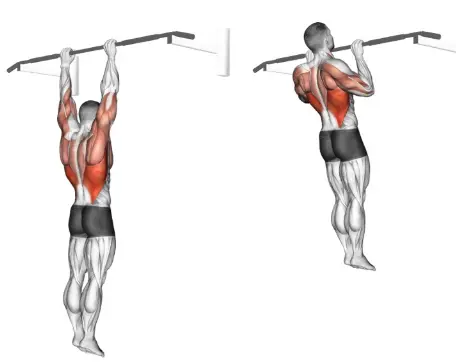
Assisted Pull-Ups
If you’re unable to perform unassisted pull-ups, using an assisted pull-up machine or resistance bands can help gradually build strength. Assisted pull-ups allow you to control the amount of assistance you need, making them accessible for people of all fitness levels.
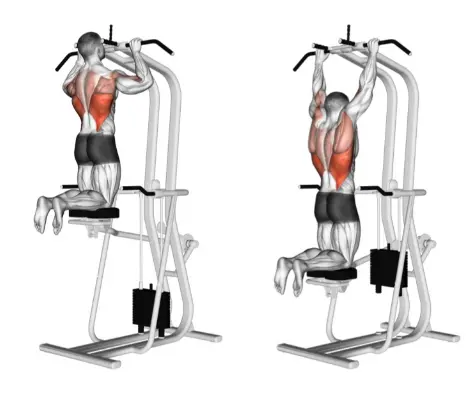
Lat Pulldown
Another great exercise to work the lats is the lat pulldown. This machine-based exercise allows you to isolate the lats while adjusting the weight according to your strength level. When performing lat pulldowns, focus on pulling the bar down towards your chest while keeping your back straight and shoulders down.

Barbell Rows
Barbell rows are a compound exercise that targets not only the lats but also the muscles of the upper back and arms. To perform barbell rows, hinge at the hips while maintaining a flat back, then pull the barbell towards your lower chest, squeezing your shoulder blades together at the top of the movement.
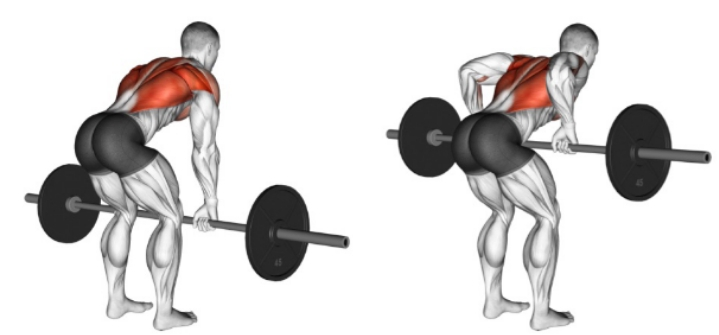
Dumbbell Rows
Dumbbell rows are a unilateral exercise that allows for greater range of motion and muscle activation compared to barbell rows. Holding a dumbbell in one hand, brace your core and row the weight towards your hip while keeping your elbow close to your body. Alternate sides for balanced development.
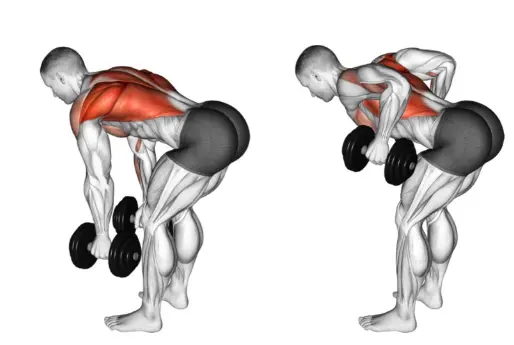
T-Bar Rows
T-bar rows are performed using a T-bar row machine or a barbell placed in a landmine attachment. With your chest up and back flat, grip the handles or barbell and row it towards your lower chest, focusing on squeezing your shoulder blades together at the top of the movement.
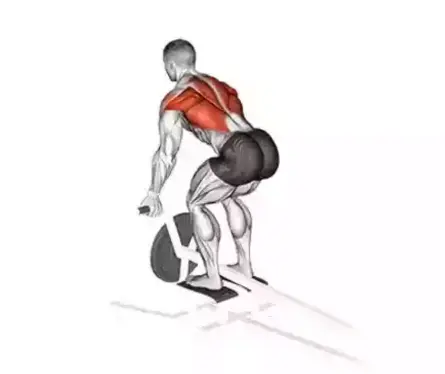
Tips for Maximizing Lat Development
For maximizing lat development, here are some tips:
- Focus on Form: Ensure proper form and technique during lat exercises to effectively target the latissimus dorsi muscles and avoid injury.
- Mind-Muscle Connection: Concentrate on engaging the lats throughout the entire range of motion, emphasizing the squeeze at the peak of each repetition.
- Full Range of Motion: Perform lat exercises through a full range of motion to maximize muscle activation and promote optimal muscle growth.
- Progressive Overload: Gradually increase the intensity or resistance of your lat exercises over time to continually challenge the muscles and stimulate growth.
- Variety of Exercises: Include a variety of lat exercises into your workout routine, including pull-ups, lat pulldowns, rows, and variations thereof, to target the muscles from different angles.
- Mix Up Grips: Experiment with different grips, like wide grip, narrow grip, overhand grip, and underhand grip, to target different areas of the lats and promote overall muscle development.
- Mind Your Elbows: Focus on pulling through the elbows rather than the hands during lat exercises to better engage the lats and reduce reliance on other muscle groups.
- Include Isolation Exercises: Supplement compound movements with isolation exercises that specifically target the lats, such as straight-arm pulldowns and single-arm lat pulldowns.
- Warm-Up Properly: Prioritize a thorough warm-up before engaging in lat exercises to increase blood flow to the muscles, improve flexibility, and reduce the risk of injury.
- Rest and Recovery: Allow proper rest and recovery between lat workouts to give the muscles time to repair and grow stronger.
- Nutrition and Hydration: Maintain a balanced diet rich in protein, carbohydrates, and healthy fats to support muscle growth and repair. Hydrate well to maximize output and recovery.
- Consistency is Key: Stay consistent with your lat training routine, aiming to perform lat exercises regularly to see continuous progress and improvement in muscle development.
By implementing these tips into your workout routine, you can effectively maximize lat development and achieve a strong, well-defined back.
Conclusion
In conclusion, including the five best lat exercises into your workout routine is key to achieving a strong and sculpted back. By targeting the latissimus dorsi muscles through exercises like pull-ups, lat pulldowns, rows, and variations thereof, you can effectively build upper body strength, improve posture, and reduce the risk of injury. Consistency, proper form, and progressive overload are important for maximizing lat development. Whether you’re a beginner or an experienced lifter, prioritizing lat exercises will not only improve your physical appearance but also contribute to overall functional fitness and athletic performance.
FAQs
Q. How many times a week should I perform lat exercises?
Aim to include lat exercises in your workout routine at least two to three times a week, allowing for proper rest and recovery between sessions.
Q. Can I build a strong back without equipment?
While gym equipment can be beneficial, bodyweight exercises like pull-ups and inverted rows can effectively target the lats and build a strong back.
Q. Are lat exercises suitable for beginners?
Yes, many lat exercises can be modified to suit beginners’ fitness levels, and gradually progress as strength and proficiency improve.
Q. Should I stretch my lats before or after a workout?
Including dynamic stretches for the lats before a workout and static stretches afterward can help improve flexibility and prevent injury.
Q. How long does it take to see results from lat exercises?
Results vary depending on individual factors such as genetics, diet, and consistency, but with regular training and proper nutrition, in a couple of weeks to months, you should observe noticeable improvements in muscle definition and back strength.

